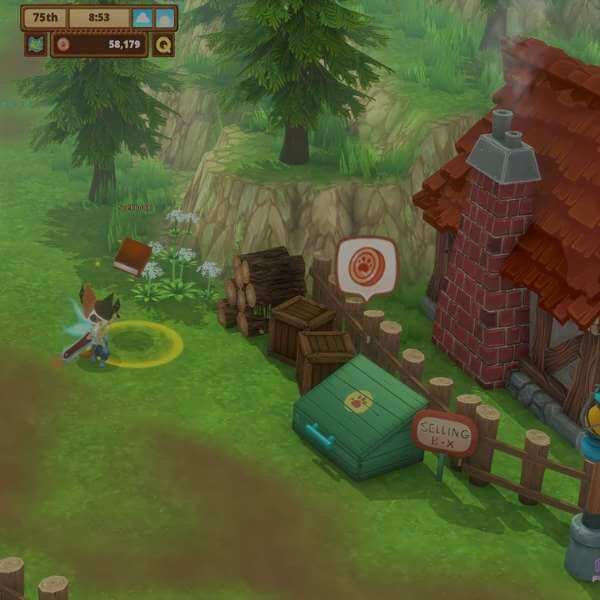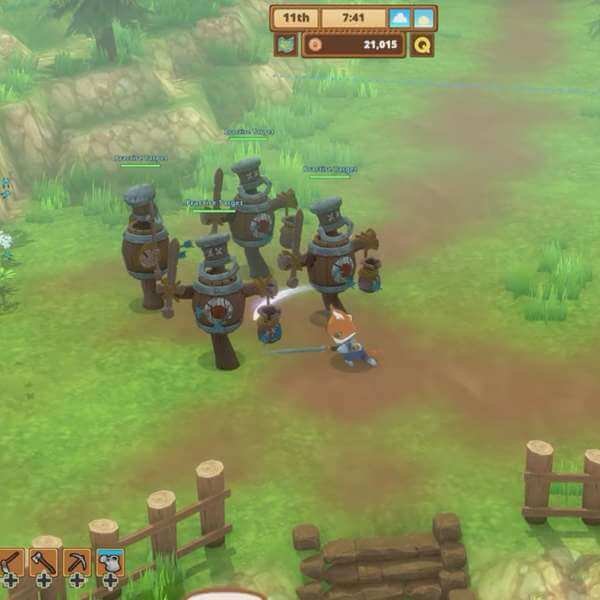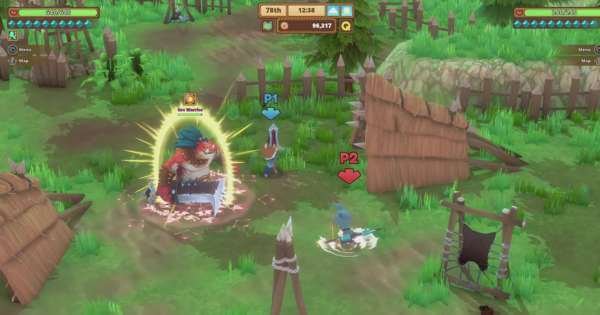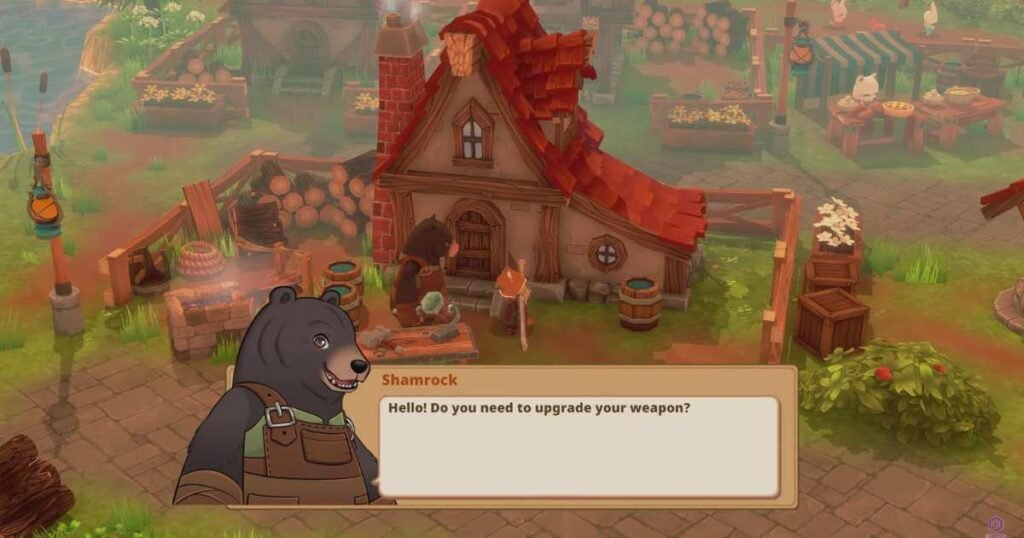Kitaria Fables is an action-adventure RPG in the vein of classics like The Legend of Zelda: Ocarina of Time, with the addition of farming and crafting. Or is it a farming sim like Harvest Moon that also includes combat?
Any way you look at it, Kitaria Fables is a game that combines two popular genres into one package, all wrapped in a charming world of adorable animal characters. As a bonus, it also offers couch co-op, allowing you to journey through the world of Canoidera with a friend.
This is the first project for Twin Hearts, a three-person indie studio from Indonesia. The team consists of Yogie (lead game designer and programmer), Yossy (2D and 3D artist) and RaGal (game designer and story writer). Speaking to Lenovo, Yogie said the team drew inspiration from games such as “Rune Factory and Fantasy Life.”
Players take on the role of Nyanza von Whiskers, a feline soldier dispatched to Paw Village to investigate reports of monster activity. The game begins with Nyanza and their pink sidekick, Macaron, traveling to Paw Village. You encounter some monsters on the way and will go through a short combat tutorial, which shows players how to equip items, attack, and dodge.
Upon arriving at Paw Village, Nyanza (or Nyan, as the character is referred to by Macaron) is greeted by Chief Oliver. After some dialogue, he guides Nyan to Thunderbunn Farm, which is your home base throughout the game.
Unsurprisingly, Thunderbunn Farm is where the farming part of Kitaria Fables comes into play. However, this mechanic isn’t unlocked until after you complete several other tasks and receive a quest from a specific character in Paw Village after about an hour of gameplay.
Aside from the farming aspect, you can also sell items with the box outside Nyan’s house, change your equipped spells and skills using the spellbook, practice combos on the target dummies, and change your character’s appearance using the mirror inside the house.



Thunderbunn Farm has all the essentials (left to right: spellbook and selling box, target dummies, mirror).
I’ve always enjoyed games that offer character customization, so the ability to change Nyanza’s appearance is one of my favorite features in Kitaria Fables. It also comes in really handy for co-op!
In addition to changing Nyanza’s overall appearance, the game also has a variety of weapons, armor, and accessories that change how your character looks. What’s cuter than a cat soldier? A cat soldier with tiny bat wings!
New gear is (mostly) obtained through the game’s crafting system. The blacksmith in Paw Village can upgrade your weapons, and the blacksmith in Rivero Fortress provides armor and accessories. There are some accessories dropped by world bosses, and a few weapons/accessories found in chests scattered across the map. Armor is only obtainable through the blacksmith at Rivero Fortress.
Gear is the only way to upgrade your character’s stats in Kitaria Fables. Want more health, attack power, or magic resistance? You need gear for that. On one hand, it’s great because you don’t have to level grind. There are no levels! On the other hand, you have to farm – a lot. This includes regular farming and item farming.


Tend your crops and fight bosses to get the necessary funds and materials for gear upgrades.
You have to plant crops in the field at Thunderbunn Farm to harvest and make various dishes to sell so you have enough money to upgrade Nyanza’s gear. You will also have to go out and farm items from the many monsters found throughout the world. Some upgrades require items dropped from world bosses that you can only get once per in-game day. Playing co-op? Double the amount of money and materials for everything.
Pro tip! Onion rings are one of the best items to sell. The recipe is accessible |
Upgrading gear was a chore throughout the game. The amount of work it takes is one of my least favorite aspects of Kitaria Fables. In theory, you could go through the whole game using the beginning equipment; it would just take forever to beat the more challenging enemies.
One of the biggest oversights regarding gear in the game comes when adding a second player to a campaign that started with a single player. If player two joins after the opening tutorial when Nyanza gets a sword, they won’t have a weapon upon joining the game.
I found this out the hard way.
I started playing Kitaria Fables solo; then, my sister joined as player two when she saw how cute it was. When she joined, I thought the game would automatically give player two a sword. Or maybe she could just use magic to attack. Nope!
Players can’t use magic unless they have a weapon equipped. You can buy a “Rusty Sword” from the traveling merchant, but upgrading player two to a decent set of gear will require a lot of materials. Depending on when they join your game, this can hinder progress on the main questline.
Early on in the game, stones are needed for a quest. These are a somewhat scarce resource because they only spawn in specific points around Paw Village or empty, un-tilled areas of your farm. To upgrade player two past the “Rusty Sword,” you need to craft a “Beginner Sword”. One of the materials required for a “Beginner Sword” is (you guessed it) stones. My sister and I spent many human hours (not in-game hours) farming stones to upgrade her sword and progress the story.

Hi there, Shamrock. Think you could cut me a deal on upgrades? No? Guess I’ll go farm some more…
Despite the issues faced with gearing up two players, the co-op mode is another one of my favorite aspects of Kitaria Fables. I enjoy co-op games and was surprised the first time I booted up the game and saw “Local Co-op” on the title screen. The best feature of co-op (other than playing with your friends, of course) is the automatic resurrection mechanic.
When you are playing in co-op mode, and one of the players is KO’d, their character will be automatically revived after a short amount of time. This is great for the bosses, which can be absolutely brutal. Sometimes Kitaria Fables feels like a Soulsborne game in disguise due to the difficulty level of boss encounters. Thankfully, that’s where the comparison to Soulslike games ends because Kitaria takes it pretty easy on players if they party wipe.
If both players are KO’d, or the main player in a solo campaign, the game automatically revives players with full health at the last place they rested (either your house or the inn). You keep all the items gathered and don’t lose anything in your inventory. The game counts this revival as a “rest,” so it does move the in-game clock forward to the next time period. Otherwise, there are no negative effects.
Kitaria Fables does away with many of the traditional mechanics associated with action-adventure RPGs that could be considered “negative” or off-putting to first-time players. Aside from lacking KO penalties, there is no weapon durability, no item stack limits (that I found), and unlimited arrows. The game does retain some RPG staples, such as stamina and ability cooldowns.
This balance of mechanics is by design. Yogie told Lenovo, “We never intended to make Kitaria Fables complicated. It had to be easy to learn but hard to master. We tried to make all features and mechanics easy to understand even for players that are not familiar with this type of genre.”
Twin Hearts succeeds in making the game accessible. The art style is appealing to a range of players, and the mechanics aren’t overly complicated, but the game still requires a certain level of skill to progress, especially in the endgame. The game’s pursuit of simplicity and accessibility is admirable, but a simple game also shines a spotlight on underdeveloped areas.
It could be argued that the stripped-back combat mechanics are too simple. The lock-on isn’t the best and often results in a “No target found” message, even when enemies are nearby. The game also lacks camera rotation, which makes it impossible to see certain portions of the map and can affect combat when your character is hidden behind an environmental set piece.

The “Forest Sanctuary” area is particularly bad.
There were also a few bugs I experienced while playing, but nothing game-breaking. Sometimes the game would get stuck on the loading screen and had to be closed and re-opened. When loading cutscenes (especially those that happened directly after resting), the player character would occasionally get stuck in a black void before everything was fully rendered.
The biggest area for improvement in Kitaria Fables is the story. The overarching story of the game and the lore of Canoidera is quite shallow. Today’s gaming landscape is full of story-rich RPGs from all kinds of developers, and Kitaria Fables doesn’t quite measure up.
Aside from the opening cutscene explaining the first Calamity, there isn’t much information about the history of Canoidera or what happened in the years between the opening cutscene and present day. There are a few “twists” in the story, but due to the lack of deeper lore and character building, these story points feel like an attempt to salvage a subpar plot rather than shocking revelations.
There are long stretches of gameplay where the main story seems like an afterthought as the player goes through various side quests unrelated to the main story. Some of these side quests are optional, but a few are necessary for story progression. While a quest that is “necessary for story progression” might seem like a main quest, the game has marked them as side quests.
Kitaria Fables has 66 side quests (in addition to the main quests), which is a lot for a game that clocks in at under 30 hours for full completion. As a gamer who thoroughly enjoys side quests, I completed every single one. That being said, there were times when my quest log was completely empty, and I was wandering around Canoidera like a stray cat, begging for someone (anyone!) to give me a quest.
Overall, Kitaria Fables is a cute RPG with a few shortcomings. I would recommend it to anyone looking for a simple, but challenging, action-adventure game with cozy elements that is easy to pick up and put down.
Have you played Kitaria Fables yet? I’d love to hear your thoughts – feel free to leave a comment below. Happy gaming!













Add comment